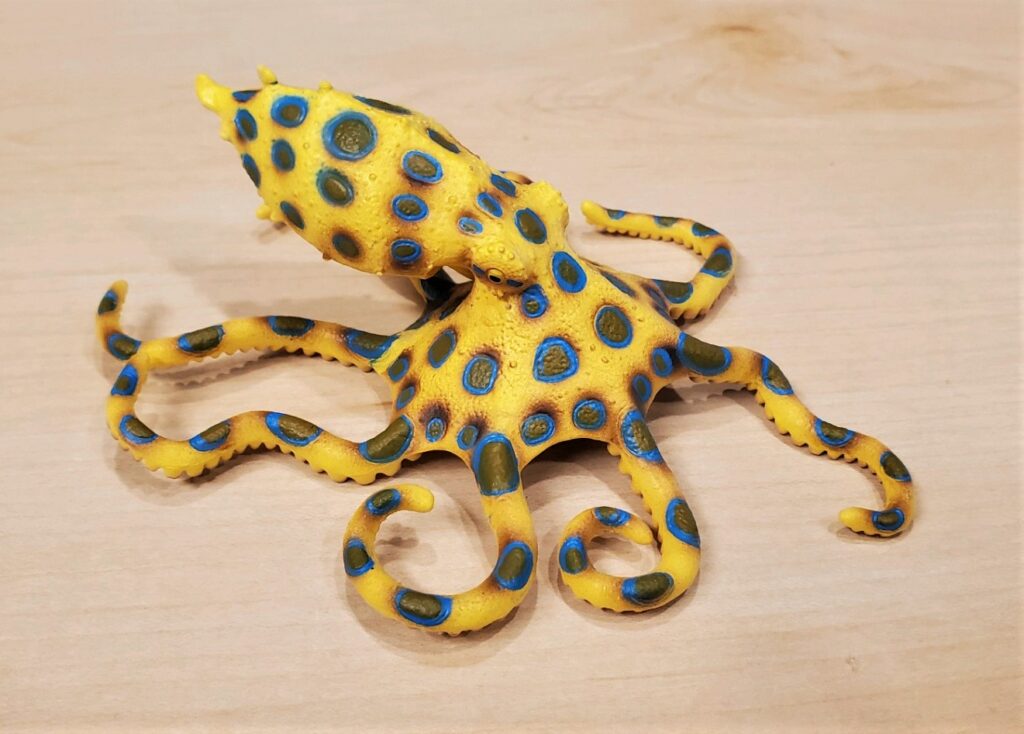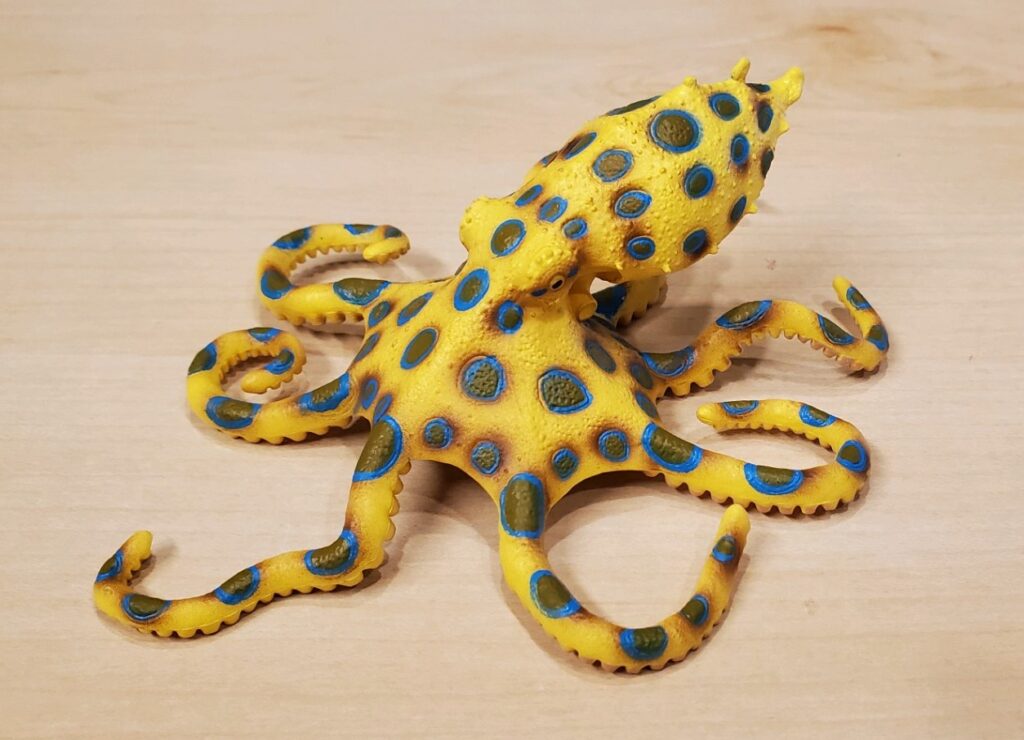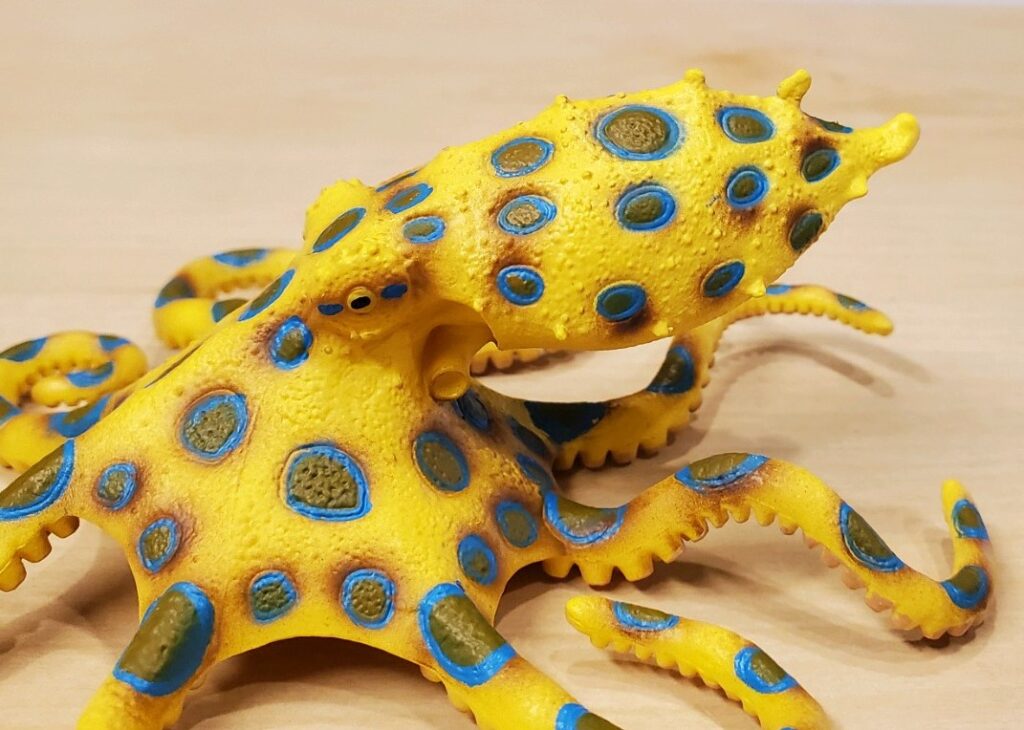When I was in high school, I did a report on the top 10 most venomous animals in the world, based on an article in one of the nature magazines I was subscribed to at the time. I don’t remember what the article’s criteria was for determining the ‘most venomous’ (potency? annual number of human fatalities?) but I was surprised to learn that 7 of the top 10 were found in Australia or the waters around Australia. Among those toxic wonders from Down Under was the focus of today’s post, the greater blue-ringed octopus, Hapalochlaena lunulata. In addition to being found around Australia, H. lunulata is broadly distributed in the Indo-Pacific, from Sri Lanka to the Philippines, Papua New Guinea, and the South Pacific. It is a benthic species, usually found in shallow waters with a mix of soft sand, rubble, and coral reefs, as well as in tide pools. Blue-ringed octopuses have two kinds of poison glands. One produces an immobilizing toxin which is mainly responsible for subduing prey, such as other benthic invertebrates. The second, a tetrodotoxin, is a defensive toxin and is the toxin that has proven fatal to humans. The bite is painless, but effects of the poison can be felt anywhere from 15 minutes after being bit to up to 4 hours. Symptoms include paresthesia, tingling and numbness in the face, lips, tongue, and extremities, excessive sweating, headaches, dizziness, speech impairment, hypersalivation, emesis, weakness, cyanosis, and petechial hemorrhages, followed shortly after by hypotension and spastic muscle paralysis. Death usually occurs between 20 minutes and 24 hours after the onset of symptoms and is usually caused by respiratory paralysis. There is no antivenom for H. lunulata.


Today we will looking at a model of this species by Bullyland, which was released in 2021. Bullyland, once one of the major players in the toy animal world, has become something of an enigma. Just when you think they are dead, they spring back up with new figures, sometimes very well done and representing interesting species. That was the case in 2021, when Bullyland not only produced today’s blue-ringed octopus, but also two species of poison dart frog, an impala (which is familiar but very rarely made), and a magnificent great green macaw, among others.

The maximum width of the figure is 12.5 cm. The mantle length is 5.5 cm, which puts it within the 1:1 size range for a larger specimen.

The figure is made of a firm PVC; I was expecting it to be slightly rubbery, at least in the arms. It has a very delicate granulate texture and all suction cups are sculpted, as are ridges above the eyes and along the center of the mantle. There is only one respiratory siphon, as there should be (several toy octopi are incorrectly sculpted with two siphons). The painting is perfect, including the dusky areas within and between the rings. This is absolutely amazing figure, and in on par with some of Bullyland’s recent spider figures.

This is by far the best figure of H. lunulata produced, and being relatively recently released, it should still be easy to find. In 2014, Kaiyodo produced a very nice figure of the related blue-lined octopus (L. fasciata) for its Capsule Q Museum line (see next pic). The Bullyland figure is larger, but they represent two species so it’s a nice way to increase taxonomic diversity in one’s collection!

Disclaimer: links to Ebay and Amazon on the AnimalToyBlog are affiliate links, so we make a small commission if you use them. Thanks for supporting us!




That’s a beautiful figure, definitely adding it to the list. Great review!